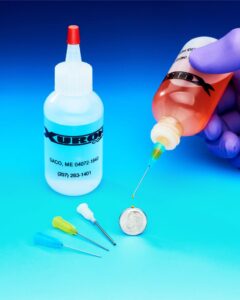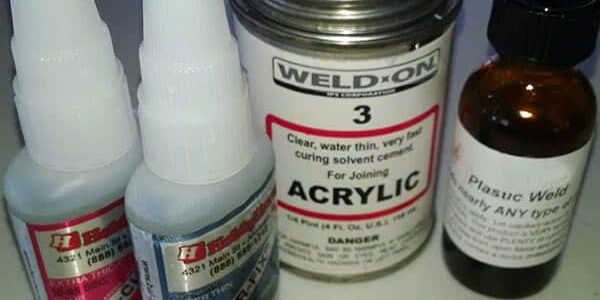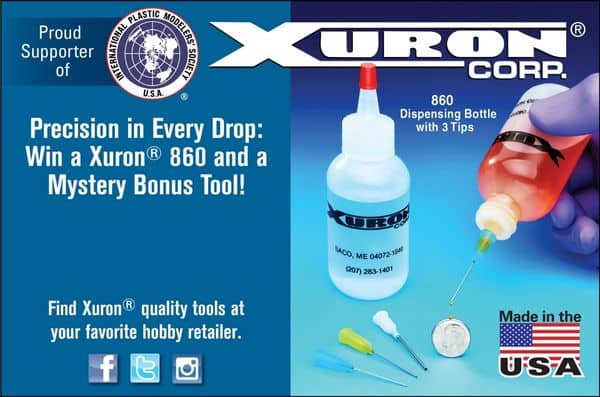In the realm of plastic scale model building and model railroading, the right adhesive and precision tools can take your craftsmanship to new heights. In this comprehensive guide, we’ll delve into the selection of glues, cements, solvents, and the essential tool for precise application – the Xuron® Model 860 Dispensing Bottle.
This is part two of a previous post that offered a broad overview of the differences between glues, cements, and solvents.
Selecting the Right Adhesive for Your Plastic Model
Adhesives play a pivotal role in every model-building project. Whether it’s tube glue, Model Cement, Super Glue® or cyanoacrylate (CA), or liquid solvents, each type has its distinct advantages and uses. Depending on your project needs, you might choose a fast-curing adhesive like Super Glue® or a welding solvent that fuses plastic pieces for a strong bond. Remember, the choice of solvent should be based on liquidity and heat properties, and always be mindful of their caveats like potential messiness, yellowing over time, or weakness against torsional forces.
First, let’s talk about the pros and cons of each adhesive …
Tube Glue or Model Cement is a gel-like substance that contains a chemical, such as Toluene, that when applied to the joining surfaces of a plastic model forms a membrane that bonds the two surfaces together. A tube of model cement is inexpensive and can be purchased at most hobby, craft, and hardware stores. It’s also available in a non-toxic, odorless version. But, model cement can be stringy and messy if proper technique isn’t used. It yellows with age. It also crystallizes and loses its adhesion properties over time.
Super Glue® or Cyanoacrylate (CA) is a fast-curing, strong adhesive. The bond is strong as it applies to weight-bearing, but weak torsionally. If you glue two objects together and try to pull them apart, CA will hold firm. However, if you push the two pieces along the seam in opposite directions it will break the bond.
Remember the classic TV commercial where a guy superglues a block fastened to the top of his hard hat to a goalpost? He can hang there all day. But if you were to tap the block that is glued to the goalpost, he and the helmet would fall to the ground. It can hold the tension of the load, but not any torsion applied to the load.
What does that mean to a scale model project? The joint of any parts glued together subject to twisting or swinging action could fail.
- • CA is great for affixing small bits or pieces that need to be held in place until other means, necessary to fasten or connect them, are in place.
- • CA comes in a variety of consistencies…water thin and jello-like thick, as well as fast and slow-curing formulas.
- • Glue something together with CA and you can reverse the process by using a CA debonder. This is a must-have item even if you only use it to unstick your fingers from each other or from the parts you’re working with.
- • CA can also be used as a filler…but that’s another topic for another post.
CA is best applied with an applicator. The applicator that I prefer is the Glue Looper® because it’s pretty much idiot-proof. For precision application, this is the tool you want.
Other options include purchasing Teflon™ tubing from a CA manufacturer, making your applicator out of a loop of fine wire, or cutting off the end of the eye of a needle. Find what works best for you.
Liquid solvents: There are several popular brands out there specifically for plastic modelers … and most who use them regularly have a favorite. Each solvent has its own properties as far as its liquidity and ‘hotness.’
Liquidity is its weight compared to water. Some are water-like; others are thinner/lighter than water so they flow differently when applied. Some evaporate slower allowing more working time; others evaporate moments after application.
Hotness or heat refers to a chemical reaction and penetration into the plastic surface. A drop of some solvents can melt a hole through a piece of plastic in seconds; some will melt or distort delicate or thin pieces.
Liquid Solvents can be applied using a brush (just make sure it’s not some synthetic plastic bristle that will melt once dipped into the solvent), a quill, or a specialized applicator such as the Touch-N-Flow.
Using a liquid solvent to bond plastic parts together is like welding two pieces of metal together. It creates the strongest, longest-lasting bond you can have. It also allows for consistency in the materials at the seam or joint so shaping and smoothing is trouble free. Whereas when using glue you’re adding a dissimilar material into the mix which will have a different hardness quality, so when you sand or shape, the glue material will remove/shape at a different rate. You might find yourself sanding away wanted plastic while barely affecting the glue.
Liquid solvents dry fast! If you make a mistake and accidentally have a misplaced drop of it on a surface … no fear … just leave it alone until it completely dries. Then it’s just a matter of polishing out the blemish it left behind. If you touch it with your finger or towel it will set your fingerprint or texture of the towel into the plastic.
The Xuron® Model 860 Dispensing Bottle
 Xuron Corp. has the tools to help you with glues and adhesives. Take a look at the #860 Dispensing Bottle: it holds up to 2 ounces and comes with three applicator needle sizes, .010”, .020” and .040”. The .010 is suitable for use with most liquid solvents used in scale modeling.
Xuron Corp. has the tools to help you with glues and adhesives. Take a look at the #860 Dispensing Bottle: it holds up to 2 ounces and comes with three applicator needle sizes, .010”, .020” and .040”. The .010 is suitable for use with most liquid solvents used in scale modeling.
The larger needles are great for applying wood, white, and other craft-type glues.
These bottles are NOT suitable for use with CA’s. But great for the precise and controlled application of the Kicker used to set CA instantly instead of using the pump spray applicator the CA manufacturer provides on their bottles.
The Xuron® Model 860 Dispensing Bottle, designed with precision, quality, and ease of use in mind, serves as a fantastic companion to your adhesive selection. This durable tool allows for exact dispensing, reducing waste and ensuring accurate glue application. It’s ideal for intricate projects where precision is key, such as plastic scale model building or model railroading.
How to Use the Xuron® Model 860 Dispensing Bottle
- ① Filling: Unscrew the top cap, insert the applicator needle size of your choice, fill the bottle with your chosen adhesive or solvent, and then fasten the cap back on.
- ② Dispensing: Hold the bottle at an angle, and gently squeeze to dispense the required amount of liquid. Always use a pulling motion, as opposed to pushing the tip away from you.
- ③ Cleaning: Once done, either insert a fine pin or wire into the nozzle to prevent airflow, or clean the bottle and nozzle to maintain its efficiency and prevent clogs.
A successful build relies on not just the right adhesive, but also a precision tool like the Xuron® Model 860 Dispensing Bottle. Intuitive, efficient, and crafted from durable material, it’s an indispensable tool for both beginners and seasoned builders alike. So the next time you embark on a model-building project, remember – adhesives matter, and so does the way you apply them.
What would you add? Do you have a tip for working with glues, cements, or solvents? Please comment below.
It’s Giveaway Time for Our Active Email Subscribers!
You could win a Xuron® 860 Dispensing Bottle and a Mystery Bonus Tool … but only if you’ve subscribed to Xuron®’s Scale Modeler’s Toolbox. We’ll randomly draw the winner’s name from our subscriber list on Monday, October 16, 2023, and will notify the winner shortly thereafter. Sign-up now using the form below!



I’ve used MEK for years. It runs like water, is quick to dry and very strong. You can get a large can of it at Home Depot for just a few dollars.
Mick, thank you for the tip!
MEK. Does melt the plastic together? What about the adhesive MELD?
Yes, MEK will melt plastic but I suggest you use the liquid solvents specifically for scale modeling. It is much safer and not as HOT. Using too strong of a solvent will do more melting than necessary potentially causing damage to the pieces being mated. I have never used MELD, my preferences are Weld-On #3 or Plast-I-Weld.~Gerald
Do you have any specific recommendations regarding the type of adhesive best suited for use with so-called rubber or vinyl tracks? It’s difficult to do any tests because there is nowhere that you can obtain any spare material, they are rarely supplied on sprues.. TIA
Rick,
There are vinyl specific adhesives but one issue is that the model mfrs use a variety of compounds to create their tracks. Some of the tracks I have dealt with had specific lugs that you used a hot iron to melt the links together. The problem with those, if you apply too little or too much heat it either is loose or you ruin the connection completely.
My trick was to use a pair of staples on each track to act as a binder. Place the joined section of track on the bottom (or in a position) where it can’t be seen. If it should be visible, apply some weathering (mud) to the tracks and wheels to conceal.
The other option…source yourself some aftermarket tracks. They add a huge amount of detail realism to your built.
i am making a model rail . problem is , the plastic glue wont stick the plastic fencing,
it comes away very easly. the glue peels of in clear strands , not touching the plastic.
not like the welding bond of the 60s that i had.
it was not a cheep plastic glue either from my model shop , it was sold as a professional glue.
the fencing just breaks away, but i dont know quite q
what the plastic fencing is made out of.
what do u sugest to stick it strong with,, that wud work today.?
Not all plastics used in modeling are the same. Some seem to be impervious to adhesives and paint.
I suggest that you clean the parts thoroughly with dish detergent then rinse well. You might try using either slow curing CA (Super Glue) or an epoxy instead of “modeling glue.” Either one will give you ample working time to align as needed. If you are working with CA, have some CA Accelerator on hand to instantly cure the CA. Some of the epoxy on the market can be fast cured with UV light and there are small UV penlight flashlights to facilitate that process.
Hope this helps. ~gerald
Xuron’s blog post on plastic model building adhesives is a treasure trove of information for hobbyists and model enthusiasts. The right adhesive can make or break a model project, and this article offers valuable insights into choosing the best one. Kudos to Xuron for helping model builders create their masterpieces!